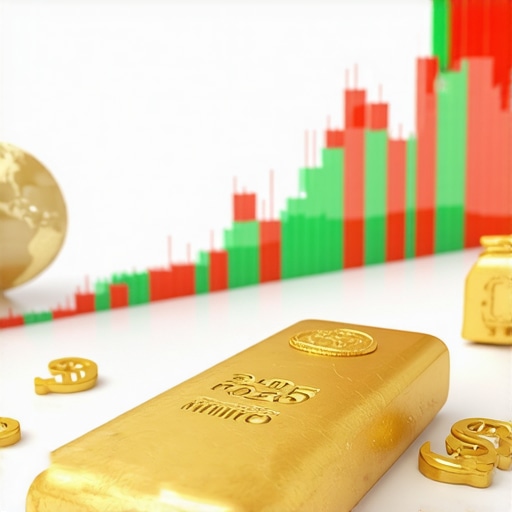Gold Demand Dynamics in an Evolving Global Economy
In the intricate landscape of global finance, understanding gold demand trends requires a nuanced analysis beyond surface-level observations. Gold’s role as a multifaceted asset—serving as a hedge against inflation, a safe haven during geopolitical instability, and a strategic reserve for central banks—positions it uniquely within the global economic framework. Recent shifts in monetary policies, fluctuating currency valuations, and emerging market growth collectively influence the patterns of gold consumption and investment demand worldwide.
Central Bank Purchases: Strategic Drivers Behind Gold Demand
One of the pivotal forces shaping gold demand is the behavior of central banks. As detailed in authoritative studies such as the IMF Working Paper on Central Bank Gold Purchases, these institutions systematically adjust their gold reserves to diversify foreign exchange holdings and mitigate currency risks. This strategic accumulation, particularly pronounced in emerging economies, significantly impacts global gold prices and demand patterns, often acting as a bellwether for investor sentiment in times of economic uncertainty.
Technological and Industrial Demand: A Complex Layer in Gold Consumption
Beyond investment and reserves, industrial applications—especially in electronics and medical devices—add a complex layer to gold demand. The interplay between technological innovation cycles and raw material requirements creates fluctuating demand that can either amplify or temper investment-driven trends. This dual nature necessitates a comprehensive approach to analyzing gold demand that accounts for both financial and industrial variables.
How Do Global Economic Policies Influence Gold Demand Volatility?
Global economic policies, including interest rate adjustments by major economies and trade regulations, contribute to gold demand volatility by altering risk perceptions and capital flows. For instance, tightening monetary policy typically dampens gold’s appeal as a non-yielding asset, whereas expansive fiscal stimulus can boost inflation expectations, enhancing gold’s attractiveness. Understanding these policy-induced demand shifts is critical for investors seeking to anticipate market movements.
Integrating Gold into a Diversified Investment Strategy
Given gold’s complex demand drivers, integrating it effectively into a portfolio demands strategic insight. Investors can benefit from exploring advanced strategies such as combining physical gold with gold ETFs and mining stocks to balance liquidity, price exposure, and yield potential. For a detailed exploration of balanced portfolio construction incorporating gold, readers may refer to this expert guide on building a balanced investment portfolio.
Call to Action: Deepen Your Expertise on Gold Market Trends
To further enhance your understanding of how gold demand trends interplay with global economic shifts, consider exploring our comprehensive analyses and investment strategies. Share your professional insights or questions to contribute to a robust discourse among experts and investors alike.
Geopolitical Tensions: Unseen Catalysts Shaping Gold Demand
Gold’s perennial status as a safe haven asset becomes especially apparent during periods of heightened geopolitical tensions. Conflicts, sanctions, and diplomatic standoffs tend to trigger spikes in gold demand as investors seek to shield wealth from market instability and currency devaluation. For instance, recent geopolitical developments in Eastern Europe and Asia have underscored gold’s role in portfolio risk mitigation. This dimension of demand is often less predictable but critically influential, intertwining geopolitical risk assessment with investment strategy formulation.
Environmental and Ethical Considerations Impacting Gold Supply and Demand
Increasingly, environmental sustainability and ethical sourcing are becoming pivotal factors influencing gold market dynamics. Investors and consumers alike are prioritizing responsibly mined gold, leading to shifts in demand towards certified products and influencing premium pricing structures. The advent of blockchain technology for supply chain transparency is enhancing trust but also adding complexity to sourcing decisions. These trends suggest that future gold demand will not only be driven by financial considerations but also by evolving social and environmental expectations.
How Can Investors Navigate Gold Demand Amidst Emerging Global Challenges?
Investors today face the challenge of integrating multifaceted global variables—ranging from geopolitical risks to ethical sourcing—into their gold investment decisions. Navigating this landscape requires a sophisticated approach that blends market analysis with geopolitical intelligence and sustainability insights. Adopting diversified gold investment vehicles such as ETFs, physical bullion, and mining stocks can offer flexibility and resilience. Moreover, staying informed through trusted sources like the World Gold Council’s Market Insights is essential for making data-driven decisions aligned with evolving market conditions.
Leveraging Technology: The Role of Digital Tools in Gold Investment Strategies
The integration of technology in gold investing is transforming how investors track, analyze, and execute trades. Advanced analytics platforms, AI-driven forecasting models, and blockchain verification systems are empowering investors to better understand supply-demand dynamics and price volatility. These tools can enhance timing strategies and risk management practices, thereby optimizing portfolio performance. For those interested in adopting such technological advantages, exploring gold trading techniques for navigating price volatility can provide valuable insights.
Strategic Adaptations in Gold Portfolio Management
Adapting portfolio strategies to the evolving gold market requires continuous reassessment of asset allocation and investment horizons. Incorporating a mix of short-term and long-term gold instruments allows investors to capitalize on market fluctuations while maintaining stability. Furthermore, integrating gold with other asset classes, including stocks and bonds, can enhance diversification and reduce systemic risk. For a comprehensive approach, consider reviewing expert strategies on balancing gold with stocks.
Call to Action: Engage with Our Expert Community for Advanced Gold Market Insights
We invite seasoned investors and market analysts to share their perspectives on navigating gold demand amid global complexities. Join the conversation by commenting below or sharing this article with peers seeking to deepen their strategic understanding of gold investment. For continuous learning, explore our advanced guides and market analyses tailored for professional investors.
Quantitative Risk Assessment Models Tailored for Gold Investment Portfolios
In an era marked by volatile geopolitical landscapes and rapidly shifting economic policies, traditional qualitative assessments of gold investment risk are no longer sufficient. Sophisticated investors increasingly rely on advanced quantitative risk models, such as Value at Risk (VaR) adjusted for tail risk and Conditional VaR (CVaR), to capture extreme market movements affecting gold prices. These models incorporate stochastic processes and Monte Carlo simulations, enabling portfolio managers to forecast potential losses under adverse scenarios with greater precision. By integrating macroeconomic variables—like real interest rates, inflation expectations, and currency volatility—into these models, one can achieve a nuanced understanding of gold’s risk-return profile within diversified portfolios.
Moreover, regime-switching models that identify structural breaks in gold demand, often triggered by policy shifts or geopolitical events, further enhance predictive accuracy. Incorporating such models helps investors anticipate abrupt changes in gold pricing dynamics, optimizing entry and exit strategies. For a deeper dive into tailored quantitative approaches, the CFA Institute’s analysis on risk management in precious metals portfolios offers comprehensive methodologies and case studies.
What Are the Emerging Best Practices for Incorporating ESG Factors into Gold Investment Risk Models?
Integrating Environmental, Social, and Governance (ESG) considerations into gold investment risk assessments is increasingly recognized as a critical dimension. Emerging best practices recommend embedding ESG risk factors directly into quantitative models by assigning financial impact scores to mining operations’ environmental compliance, labor practices, and governance standards. For example, ESG-related disruptions—such as regulatory penalties or supply chain interruptions—can be modeled as event risks within Monte Carlo simulations, adjusting expected returns and volatility metrics accordingly. Additionally, scenario analysis focused on regulatory tightening around sustainable sourcing can help forecast potential shifts in gold supply-demand equilibrium, thereby affecting price volatility and portfolio risk.
Practitioners are also leveraging big data analytics and machine learning to process ESG-related news sentiment and social media trends in real-time, enabling more dynamic risk adjustments. By combining traditional financial risk metrics with ESG overlays, investors gain a holistic perspective that aligns with evolving fiduciary responsibilities and market expectations.
Macro-Financial Interlinkages: Gold’s Role Amidst Currency Fluctuations and Inflationary Pressures
Gold’s behavior in relation to currency valuations and inflation dynamics remains a focal point for expert investors. The metal’s inverse correlation with the US dollar, a phenomenon well-documented during periods of monetary easing or tightening, directly influences international gold demand patterns. Yet, this relationship is not static—emerging evidence suggests that the elasticity of gold prices to currency fluctuations varies significantly depending on inflation regimes and real interest rate environments.
Advanced econometric analyses reveal that during stagflationary periods, gold’s correlation with inflation strengthens, positioning it as a more effective hedge. Conversely, in deflationary environments or when real yields rise sharply, gold’s opportunity cost increases, curtailing demand. These nuanced interlinkages require investors to adopt dynamic hedging strategies, employing derivatives and cross-asset portfolios to optimize risk-adjusted returns. The National Bureau of Economic Research’s working paper on gold and macroeconomic variables provides an authoritative framework elucidating these complex relationships.
Emerging Markets and Gold: Opportunities and Structural Challenges
Emerging markets continue to be pivotal drivers of gold demand, fueled by rising incomes, cultural preferences, and monetary policies favoring gold reserves. However, investing in these regions presents structural challenges such as regulatory opacity, currency risks, and fluctuating capital controls. From an investment strategy perspective, incorporating emerging market gold demand requires granular country-level analysis and scenario planning, taking into account political stability, fiscal discipline, and trade dynamics.
Institutional investors are increasingly adopting hybrid approaches that combine exposure to physical gold holdings with investments in region-specific gold mining equities and ETFs designed to capture local market nuances. This approach balances direct asset security with growth potential linked to emerging market economic expansion.
Call to Action: Elevate Your Gold Investment Strategy with Cutting-Edge Risk Analytics
To harness the full potential of gold within your investment portfolio, we encourage you to explore advanced risk management frameworks and ESG integration techniques. Engage with our expert community to exchange insights on quantitative modeling, macroeconomic interdependencies, and emerging market strategies. Stay ahead by subscribing to our detailed reports and participating in upcoming webinars focusing on sophisticated gold investment methodologies.
Innovations in Quantitative Models Enhancing Gold Investment Precision
As gold markets grow increasingly volatile amidst geopolitical upheavals and shifting macroeconomic conditions, investors are turning to cutting-edge quantitative techniques that transcend traditional valuation frameworks. These innovations include regime-switching models that dynamically identify structural shifts in gold demand, alongside stochastic volatility models which better capture nonlinear price behaviors under extreme market stress. By embedding macroeconomic indicators such as inflation surprises and currency volatility indices into these frameworks, portfolio managers can enhance predictive accuracy and optimize hedging strategies more effectively.
Next-Generation ESG Metrics Transforming Gold Risk Assessments
The infusion of Environmental, Social, and Governance (ESG) factors into gold investment risk models represents a paradigm shift toward sustainability-conscious asset management. Advanced practitioners now incorporate granular ESG scoring algorithms, leveraging natural language processing to analyze real-time news sentiment and social media discourse surrounding mining operations. This approach enables the quantification of latent reputational risks and regulatory exposures, factoring these into Monte Carlo simulations to forecast potential impacts on returns and volatility. Additionally, scenario analyses are calibrated to anticipate tightened global regulations on responsible sourcing, thus informing more resilient portfolio construction.
What Are the Most Effective Quantitative Techniques for Incorporating ESG Risks into Gold Portfolios?
Integrating ESG risks into quantitative gold portfolio models requires a multifaceted methodology. Leading techniques involve assigning weighted ESG risk scores to mining companies, which are then incorporated as stochastic event variables within Value at Risk (VaR) and Conditional VaR (CVaR) frameworks. Machine learning classifiers can detect patterns in ESG-related adverse events, enhancing scenario generation for stress testing. Furthermore, sentiment analysis tools process vast unstructured data to dynamically adjust risk parameters, offering a forward-looking perspective on ESG impact. For comprehensive methodologies and empirical validation, the CFA Institute’s Digest on Advanced Risk Management in ESG Investments provides authoritative guidance.
Synergizing Macro-Financial Dynamics with ESG to Refine Gold Hedging
The interplay between macroeconomic variables and ESG considerations is becoming an essential frontier in gold investment management. For instance, inflationary pressures may amplify the relevance of gold as an inflation hedge, but ESG-driven supply constraints could simultaneously introduce price supply shocks. Incorporating dual-factor models that align real interest rate forecasts with ESG risk indices allows investors to anticipate complex demand-supply disequilibria. This holistic view facilitates more nuanced derivative positioning and cross-asset hedging tactics, especially within emerging economies where ESG regulation is evolving rapidly.
Harnessing Artificial Intelligence to Navigate Complex Gold Market Interdependencies
Artificial intelligence (AI) and machine learning applications are revolutionizing how investors interpret multifactor datasets in gold markets. By training algorithms on historical pricing, geopolitical event flows, ESG incident data, and macroeconomic releases, AI platforms can generate probabilistic forecasts that adapt to regime changes. Reinforcement learning agents optimize portfolio rebalancing by simulating diverse market scenarios, while natural language processing tools extract early warning signals from global newsfeeds. These advancements empower sophisticated investors to maintain agility amid uncertainty.
Call to Action: Participate in the Frontier of Gold Investment Analytics
To capitalize on these advanced methodologies, we invite portfolio managers, quantitative analysts, and sustainability experts to engage with our specialized forums and workshops. Share your experiences integrating ESG analytics with quantitative risk models or explore collaborative research opportunities. Subscribe to our cutting-edge reports and webinars designed to elevate your strategic gold investment insights.
Expert Insights & Advanced Considerations
Dynamic Integration of ESG and Quantitative Risk Models Enhances Gold Portfolio Resilience
Incorporating Environmental, Social, and Governance (ESG) criteria within sophisticated quantitative frameworks, such as Value at Risk (VaR) and Conditional VaR (CVaR), provides a nuanced lens for assessing gold investment risks. By quantifying ESG-related event probabilities and embedding them into Monte Carlo simulations, investors can preemptively adjust portfolios to mitigate reputational and regulatory shocks, elevating their risk management beyond traditional financial metrics.
Regime-Switching Models Capture Structural Shifts in Gold Demand Amid Macroeconomic Fluctuations
Gold demand exhibits non-linear responses to evolving monetary policies, inflation regimes, and geopolitical events. Regime-switching econometric models that detect structural breaks enable investors to anticipate abrupt demand changes, facilitating more precise timing for entry and exit strategies. This dynamic approach is indispensable amid the complex macro-financial interlinkages shaping gold markets today.
Artificial Intelligence Empowers Adaptive Forecasting in an Uncertain Gold Market
Leveraging machine learning algorithms and natural language processing, AI platforms analyze multifactor datasets—including geopolitical developments, ESG incident reports, and inflation surprises—to produce probabilistic forecasts. These adaptive models enable portfolio managers to dynamically recalibrate allocations and hedge positions, fostering agility and enhanced decision-making precision in volatile gold markets.
Emerging Markets Demand Requires Granular, Country-Level Risk Assessment for Optimal Exposure
While emerging economies drive significant gold demand growth due to cultural and monetary factors, challenges such as regulatory opacity and currency volatility necessitate detailed, localized analysis. Combining physical gold holdings with region-specific mining equities and ETFs aligned to local market conditions enables investors to balance asset security with growth potential effectively.
Macro-Financial and ESG Interdependencies Call for Dual-Factor Hedging Strategies
Inflation pressures and ESG-driven supply constraints interact to create complex gold price dynamics. Dual-factor models that integrate real interest rate forecasts with ESG risk indices offer a comprehensive framework for anticipating supply-demand disequilibria, optimizing derivative use and cross-asset hedging, particularly in jurisdictions with evolving ESG regulations.
Curated Expert Resources
- World Gold Council’s Market Insights: A premier source for in-depth analysis on global gold demand trends, pricing dynamics, and investment strategies, invaluable for staying abreast of evolving market conditions.
- CFA Institute’s Research Digest on Risk Management for Precious Metals Portfolios: Offers authoritative methodologies on quantitative risk modeling, including ESG integration, essential for advanced portfolio risk assessment.
- National Bureau of Economic Research (NBER) Working Papers: Provides rigorous econometric studies on macroeconomic variables affecting gold prices, critical for understanding complex intermarket relationships.
- BuyingGoldNow’s Expert Guides: Comprehensive resources such as Analyzing Gold Demand Trends and Top Gold Investment Strategies provide practical insights tailored for sophisticated investors.
- CFA Institute’s Digest on Advanced Risk Management in ESG Investments: Detailed guidance on integrating ESG risks quantitatively into investment models, supporting sustainable portfolio construction.
Final Expert Perspective
Understanding and navigating gold demand trends today requires a fusion of advanced quantitative techniques, ESG consciousness, and acute macro-financial awareness. The evolving landscape—marked by geopolitical tensions, inflationary shifts, and sustainability imperatives—demands that investors adopt dynamic, data-driven strategies incorporating regime-switching models and AI-powered analytics. By leveraging granular emerging market insights and dual-factor hedging frameworks, expert investors can optimize portfolio resilience and capitalize on gold’s multifaceted role as both a safe haven and strategic asset. For those committed to deepening expertise and refining investment acumen, engaging with specialized resources like the comprehensive analysis of gold demand trends and strategic gold investment guides is essential. We encourage professionals to contribute insights, share experiences, and remain at the forefront of gold market innovation to maximize their strategic advantage.










